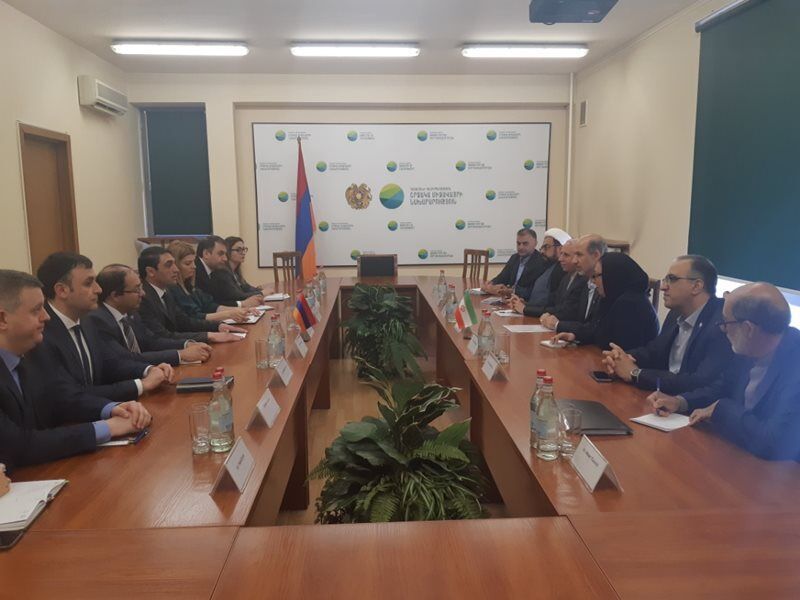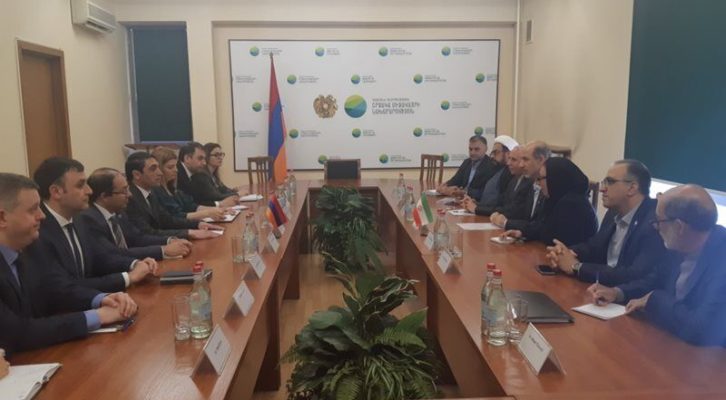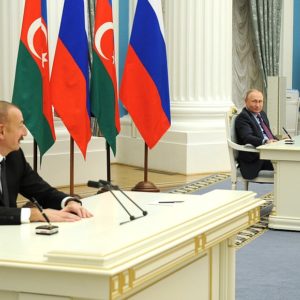
Iranian Minister of Energy Ali Akbar Mehrabian in a meeting with Minister of Environment of Armenia Hakob Simidyan, May 11, 2022 (Photo: IRNA News Agency/Twitter)
In recent months, Iran has engaged in active foreign policy in the South Caucasus to push its geo-economic interests forward. Meanwhile, Western-led economic sanctions have pushed Russia to realize the significance of the North-South trade route. Iran defused and refreshed its relations with Azerbaijan and by engaging with Armenia it decreased Baku’s political pressure on Yerevan. The following analysis will highlight the recent events and the role Armenia and Azerbaijan play in Iran’s regional trade and economic interests.
Defusing Relations with Azerbaijan
On March 11, 2022, Azerbaijan and Iran signed an agreement to establish new railway, highway and energy supply lines connecting the southern territories of Karabakh/Artsakh captured by Azerbaijan to the Nakhichevan exclave. According to the agreement, the new highway will be 55 kilometers long and start from Zankelan’s Aghbend. In addition to the highway, two railway bridges and a road bridge will be constructed over the bordering Arax River. The highway will eventually pass through northern Iran and connect to Nakhichevan’s Ordubad village.
In his article “Construction of Highway and Railway Links Between Zangilan and Nakhchivan: The Views From Baku and Tehran,” Iranian political analyst Vali Kaleji highlights that this project has geo-economic importance for Azerbaijan and Iran.
For Baku, the construction of this trans-Iranian Aghbend-Ordubad highway is essential for three reasons. First, it is a continuation of the Horadiz-Jabrayil (Cheragan)-Zankelan-Aghbend highway as this transit will push investors to invest in the southern regions of Karabakh currently under the control of Baku. Second, the 55-kilometer highway through Iran will be an alternative to the “Zangezur corridor” that Azerbaijani President Ilham Aliyev was pushing for after the November 9, 2020 trilateral statement. With Iranian help, this alternative route will relieve some pressure off Armenia’s shoulders, as Baku was threatening to gain a corridor through the strategic Syunik region of southern Armenia and cut Armenia’s border with Iran. Moreover, Baku is also concerned that if PM Nikol Pashinyan’s government falls and the opposition comes to power, the new rulers will not provide any corridor to Azerbaijan through the Armenian territories. Hence, as Keleji noted, “Baku is deliberately pursuing another option should the Zangezur corridor not come to fruition.” Finally, Azerbaijan will establish a link with Nakhichevan through Iran, which will provide additional Iranian leverage over Azerbaijan in the future.
Iran, in turn, has its own considerations and interests for allowing the construction of a highway and railway between Zankelan and Nakhichevan across its own territory. In reaction to the expansionist narrative pushed by Azerbaijan over the “Zangezur Corridor” and Azerbaijani incursion over bordering villages in Syunik, Iran drew its red lines, and the Iranian Revolutionary Guard Corps threatened to use military force to prevent any territorial change in its 44-kilometer border with Armenia. As such, Tehran sees the construction of a new highway and railway line between Zankelan and Nakhichevan via Iran as an appropriate alternative to the “Zangezur corridor” that will lower the military pressure on southern Armenia. For this reason, Ahmad Kazemi, an Iranian expert on the South Caucasus region, called the March 11 Iranian-Azerbaijani transit agreement “Baku’s reconciliation with geopolitical realities.” According to Kazemi, “the fact is that the Republic of Azerbaijan, after more than a year of efforts and adherence of Ankara’s and Tel Aviv’s approach in discussing of the fake Zangezur corridor or NATO Turan corridor, concluded that this corridor is imbued with historical aspirations, and territorial, security and political expectations will not be realized. Because the fake Zangezur corridor is basically a plan made and discussed in the think tanks of NATO, Turkey and the Zionist regime, which is aimed against the fundamental interests of Iran, Russia, and China. It is obvious that Iran, Russia and China will not allow geopolitical changes on the southern borders of Armenia to implement the fake Zangezur corridor in accordance with the UN Charter, which prohibits any change in the international borders.” In addition to this route, Iran is seeking to complete the construction of the Rasht-Astara railway to connect with Azerbaijan and access Russia and the Eurasian Economic Union market via a railway through Azerbaijan.
Meanwhile, with the ongoing war in Ukraine, Moscow has started to realize the importance of the North-South trade route. According to Kaleji, by strengthening this transit route, Moscow hopes to counter the tightening economic sanctions and transit restrictions on Russia that the West adopted in response to the war in Ukraine. In this regard, the Iranian Roads and Urban Development Minister Rostam Qasemi visited Moscow on April 30, 2022. Following his talks with Russian Transport Minister Vitaly Savelyev, the two officials signed a comprehensive agreement on cooperation in the field of transportation. Both ministers noted the importance of establishing a railway connecting both countries. The ministers also emphasized the need to complete the missing Rasht–Astara part of the International North-South Transport Corridor (INSTC) as soon as possible. The 164 kilometer Rasht-Astara railway has faced years of construction and implementation problems. The main obstacle has been financing, particularly due to US sanctions on Iran. In 2016, the International Bank of Azerbaijan promised to allocate $500 million loans, however, the American side pressured Baku to give up the idea.
Nevertheless, Tehran is eager to implement this important railway project, along with other railway projects in the region. The Iranian-Armenian railway line from Meghri in Armenia’s Syunik province could have been an alternative, but it suffers from high costs and has not seen any progress since 2009. Plans to restore the Soviet-era east-west railway in the South Caucasus following the November 9, 2020, trilateral statement have not been implemented as the Azerbaijani side has interpreted the opening of communication routes into a “corridor” with a certain status carving the Armenian-Iranian border. Hence, the construction and completion of the Rasht-Astara railway, for now, is the only practical and accessible short-term prospect for Iran to connect to the South Caucasus. This would further isolate Armenia from regional trade routes. For Iran, its implementation will complete the last remaining section of the INSTC and create a railway connection for Azerbaijan, Georgia and Russia to Iran’s Chabahar Port on the Oman Sea and Bandar Abbas on the Persian Gulf.
Engaging in Proactive Relations with Armenia
Armenia’s poor infrastructure, slow progress in the construction of the 556-kilometer North-South highway connecting Georgia with Iran and the conflict over Artsakh with Azerbaijan have further isolated and delayed its participation in the regional economic project. Over the past few months, both Iran and India have been pushing Armenia to take crucial steps to be part of this North-South transport project. Important meetings between Iranian and Armenian officials have taken place over the past three months to address trade, transit and energy issues:
- On March 2, 2022, Reza Fatemi-Amin, Iranian Minister of Industry, Mining and Trade led a high-ranking delegation of trade officials and private entrepreneurs to Armenia—the first of its kind since President Raisi took office last summer. CEOs of 35 Iranian private companies also accompanied the delegation. Iranian and Armenian officials discussed the implementation of trade agreements, cooperation in free zones, commodity trade, transportation and customs.
- On April 29, 2022, Iran’s Finance and Economic Minister Ehsan Khandouzi headed a delegation to Yerevan to meet Armenian officials and negotiate with the Armenian side over trade. The Iranian side argued that there is still great potential for further expansion of bilateral cooperation and bringing the trade turnover between both sides to $1 billion. The Iranian minister also stated that the Iranian side attaches great importance not only to the development of trade with Armenia but also considers it as a “gateway” to the markets of Russia and other Eurasian Economic Union (EAEU) member countries.
- On May 11, 2022, Iranian Energy Minister Ali-Akbar Mehrabian traveled to Yerevan to attend the 17th Iran-Armenia Joint Economic Committee meeting to discuss transit, transportation, trade and energy.
- On May 16, 2022, the Iranian Minister of Transport and Urban Development Rostam Ghasemi met with the Minister of Territorial Administration and Infrastructure of the Republic of Armenia Gnel Sanosyan to discuss the details of bilateral transit cooperation and joint infrastructural projects. Both sides expressed their willingness for reaching agreements that would facilitate transit and trade between the two countries and in the region.
- Also on May 16, 2022, during a virtual meeting with Armenia’s Minister of Territorial Administration and Infrastructure Gnel Sanosyan, Kheirollah Khademi, director-general of Iran’s Construction and Development of Transportation Infrastructures Company, pointed to previous negotiations and visits to Armenia for the implementation of the road route connecting Iran’s bordering city Nurduz to Yerevan. Khademi discussed Iran’s preparation in the construction of the southern part of the strategically important Tatev Road in Sisian connecting it to Nurduz (Iran is interested in the construction of a tunnel and the development of Nurduz Terminal). Khademi also added that Tehran is ready to export technical and engineering services to Armenia to finalize the construction of the route from the Iranian border to Yerevan.
- In 2021, 22,500 Armenian trucks and 24,000 Iranian trucks were recorded to have passed from the Armenian-Iranian border. Commenting on the increase of the regional transit, Javed Hedayati, the general director of Iran Transit and International Transportation Bureau at Iran’s Road Maintenance and Transportation Organization, proposed for commercialization of the Iranian-Armenian trade routes. Both sides attributed the increase in transit to the importance of the International North-South Transport Corridor (INSTC) and newly signed Persian Gulf-Black Sea Agreement. For the rail connection, Miad Salehi, head of the Islamic Republic of Iran Railways, highlighted three possibilities for rail transit between Iran and Armenia. The first two rail connections are:
- The Jolfa-Nakhichevan-Yerevan
- The Jolfa-Nurduz (in Iran) and Yerevan-Nurduz (in Armenia) railroads were agreed upon seven years ago. They have yet to be realized.
- The multi-modal transit from Yerevan to Jolfa by road and then southward to the Port of Bandar Abbas by rail. In October 2021, Khademi (Iran’s Deputy Transport Minister) headed a delegation to Armenia to consider the participation of Iran in completing the Tatev Road as an alternative route to Goris-Kapan Road, which would bypass the highway handed over to Azerbaijan by the Armenian authorities, due to the heavy tolls levied to Iranian fleets.
- On May 17, 2022, the Iranian Oil Minister Javad Oji met with the Armenian Minister of Territorial Administration and Infrastructure Gnel Sanosyan in Tehran and expressed Iran’s readiness for swapping Turkmenistan’s natural gas with Armenia. Minister Oji also said the National Iranian Gas Company’s (NIGC) is ready to increase gas exports to neighboring Armenia. “Negotiations for gas swap from Turkmenistan to Armenia have started, and we will soon achieve good results in this regard due to the high capacity of the country’s gas network,” added the Iranian minister. In 2004, the two countries signed a gas-for-electricity barter deal in which Iran would export gas to Armenia’s power plants as Armenia exports electricity to Iran over a 20-year period.
Conclusion
After November 9, 2020, Iran felt isolated from the region, but its absence didn’t last long. With the election of President Ebrahim Raisi, Tehran adopted a proactive foreign policy in the South Caucasus to secure its geo-economic interests. The so-called Zangezur corridor was a threat to Iran’s national security as it was going to bypass not only the Iranian territory and prevent Iran from gaining transit fees from the Azerbaijani trucks, but was also going to carve out international borders between Iran and Armenia.
Iran had to play its cards and engage both Azerbaijan and Armenia to secure its interests. On one hand, Tehran fostered the construction of a railway with Azerbaijan to connect with Russia, and on the other hand started to increase its trade, energy and communication projects with Armenia. Iran’s engagement with Azerbaijan over the alternative “corridor” lifted the military and political pressure on Armenia regarding the Azerbaijani threat over Syunik, but at the same time kept Armenia isolated from regional communication and trade projects for the time being.
The article was originally published in the Armenian Weekly, on 25/5/2022.
Yeghia Tashjian is a regional analyst and researcher. He has graduated from the American University of Beirut in Public Policy and International Affairs. He pursued his BA at Haigazian University in political science in 2013. In 2010, he founded the New Eastern Politics forum/blog. He was a research assistant at the Armenian Diaspora Research Center at Haigazian University. Currently, he is the regional officer of Women in War, a gender-based think tank. He has participated in international conferences in Frankfurt, Vienna, Uppsala, New Delhi and Yerevan. He has presented various topics from minority rights to regional security issues. His thesis topic was on China’s geopolitical and energy security interests in Iran and the Persian Gulf. He is a contributor to various local and regional newspapers, a columnist in the Armenian Weekly and a presenter of the “Turkey Today” program for Radio Voice of Van. Recently he has been appointed as associate fellow at the Issam Fares Institute for Public Policy and International Affairs at the American University of Beirut and Middle East-South Caucasus expert in the European Geopolitical Forum.







